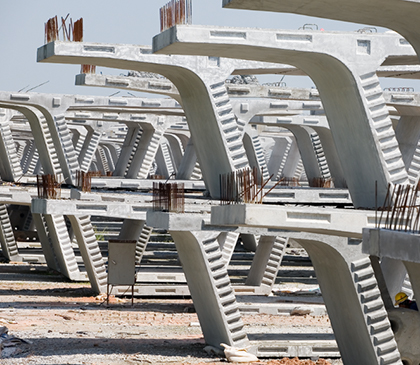Precast Concrete Technology is a construction technology where building members such as walls, slabs, stairs, aqueducts, culverts, and tunnels. In many cases, you see in-situ concrete work where fresh concrete is filled in the molds at the site and left for settling. This takes time and in this case, of faster work progress the structure needs to be cast at another place and then brought to the site and fitted with the other members.
Types and Systems:
The precast concrete is also called the prefabricated construction technique. For such construction technology, the building members are standardized in shape and size with pre-determined stress values.
The prefabricated concrete members are of many types where they are classified in large panel systems, frame systems, slab-column systems with walls. These systems are nowadays used in multistory buildings where the dimensions of the building are pre-determined and then fitted on site. The precast concrete work is used most in the bridge and metro rail work. In Mumbai, you can see the prefabricated concrete slabs being used in the metro work where slabs and decks are prefabricated.
Advantages:
1. Fewer tools, machinery, and equipment are required
2. Compared to in-situ concrete work, precast concrete work is faster and has less effect on the environment.
3. In prefabricated concrete work, increases efficiency and has high-quality controls and better finishing.
Disadvantages:
1. Skilled workers are needed.
2. Transportation of prefabricated concrete slabs and elements.
3. The precast plant needs to be near the site to lower the cost.
4. Machines such as cranes ad lifters need to place the elements.




ReplyDeleteNice work, I always love to make the space beautiful. Keep sharing to get more creative ideas for us.
Best Construction Company in Chennai
Best Residential Architects in Chennai
Home Interior Designers in Chennai
construction consultant company in chennai
Top Builders in Ambattur
Looking for reliable Building Contractors in Chennai? Look no further! This insightful article explores the innovative precast concrete technology, shedding light on its benefits and applications. Whether you're planning a commercial or residential project in Chennai, understanding this construction method is crucial. Trust The Core Engineers to deliver quality insights for your construction needs in the bustling city.
ReplyDelete
ReplyDeleteThe article on precast concrete technology by Core Engineers is insightful. As a reputable choice among Building Contractors In Chennai, it's crucial to stay updated on innovative construction methods like precast concrete. This technology not only streamlines construction processes but also ensures quality, durability, and cost-efficiency. The detailed explanation of its benefits and applications showcases Core Engineers' expertise in modern construction techniques. Embracing precast concrete technology can revolutionize construction practices in Chennai, offering numerous advantages for both builders and clients. Looking forward to more informative content from Core Engineers!
"Explore the future of construction with The Core Engineers! Their insightful blog delves into the revolutionary Precast Concrete Technology, shedding light on its numerous advantages and applications. As one of the leading Civil Engineering Companies In Chennai, The Core Engineers showcases their expertise in embracing innovative techniques for sustainable and efficient construction. Whether you're a professional in the field or a curious enthusiast, this blog offers invaluable insights into the evolving landscape of civil engineering. Dive into their expertise today and discover how Precast Concrete Technology is shaping the future of construction in Chennai and beyond!"
ReplyDeleteExcellent blog.
ReplyDeleteBuilding Contractors in Chennai
Architects in Chennai
I also want to be a writer like you. Your writing is my inspiration.
ReplyDeleteconstruction company in Chennai
building construction company in Chennai